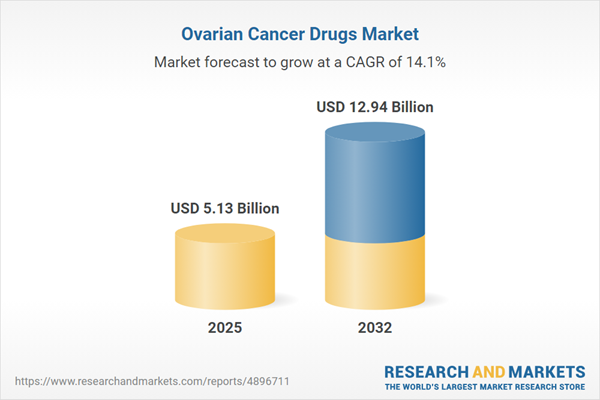Speak directly to the analyst to clarify any post sales queries you may have.
The ovarian cancer drugs market continues to advance as innovation in targeted therapies, evolving regulatory standards, and dynamic commercialization strategies shape the competitive landscape. Senior leaders require actionable analysis to steer portfolios, address operational risks, and anticipate global trends in this complex environment.
Market Snapshot: Ovarian Cancer Drugs Market
Globally, the ovarian cancer drugs market is exhibiting strong growth, propelled by widespread adoption of tumor-specific therapies and major developments within immuno-oncology. Precision medicine has introduced new best practices for patient management, driving a shift among healthcare systems and demanding continuous adaptation from providers. Regulatory conditions are evolving quickly, requiring pharmaceutical organizations to refine value propositions to meet growing expectations from stakeholders. Cross-regional partnerships are spurring quicker development and access to innovative drugs, redistributing influence among established and emerging markets. In this shifting context, business leaders must reevaluate portfolios, accelerate go-to-market timelines, and maintain operational flexibility to keep pace with rapid policy and market changes.
Scope & Segmentation
This report is structured to help senior executives effectively navigate the ovarian cancer drugs sector by offering a practical segmentation framework and clear analysis to support risk management, investment choices, and operational strategy.
- Cancer Types: Epithelial ovarian cancer, germ cell tumors, stromal cell tumors, and small cell ovarian cancer. Each presents distinct clinical pathways and market factors that affect therapy selection and access strategies.
- Treatment Types: Chemotherapy, hormonal therapy, immunotherapy, radiation therapy, and targeted drugs. These categories reflect the expanding choices available to healthcare providers and their patients, emphasizing evolving adoption patterns and treatment demands.
- Therapeutic Classes: Angiogenesis inhibitors, PARP inhibitors, PD-L1 inhibitors, and innovative classes. These enable progress toward personalized medicine and differentiate products within development pipelines.
- Administration Routes: Intravenous and oral. These options shape delivery models, influence operational procedures, and impact patient experience.
- Distribution Channels: Hospital pharmacies, retail pharmacies, and online platforms. Each requires distinct strategies for regional market access, logistics management, and supply chain resilience.
- End Users: Cancer centers, clinics, and hospitals. These key providers determine how fast innovations are integrated into existing care models.
- Key Regions: Americas, Europe, Middle East, Africa, and Asia-Pacific. Regulatory climates in leading countries including China, India, and Japan inform commercialization tactics and partnership opportunities.
- Featured Companies: AstraZeneca PLC, F. Hoffmann-La Roche Ltd, Merck & Co., Inc., GlaxoSmithKline plc, Clovis Oncology, Inc., ImmunoGen, Inc. These players drive innovation and shape global expansion.
Understanding these segments enables leadership teams to focus R&D spend, anticipate technological shifts, and strengthen commercialization pathways across core and emerging regions. Each defined segment reflects unique adoption challenges, regulatory forces, and investment priorities relevant to executive planning.
Key Takeaways & Strategic Insights
- Implementing biomarker-driven strategies positions organizations to better align with payer requirements, regulatory frameworks, and patient-centered care models.
- Combination treatment paradigms are broadening the clinical landscape, offering enhanced resistance management and expanding commercial opportunities for product pipelines.
- Regional pricing and reimbursement variances necessitate agile access planning and tailored affordability solutions for different patient populations worldwide.
- Enhancing supply chain robustness by diversifying sourcing and expanding domestic manufacturing reinforces product continuity and reduces vulnerability to external shocks.
- Innovative modalities, including cell-based therapies and antibody-drug conjugates, are guiding the sector toward next-generation breakthroughs while addressing unmet clinical needs.
- Digital health integration and real-world data utilization are streamlining research activities and producing clearer measures of clinical and operational performance.
Tariff Impact on Ovarian Cancer Drug Supply Chains
Recent U.S. tariff measures on pharmaceutical imports have led to stepped-up domestic manufacturing and the diversification of supplier networks. This approach is intended to stabilize drug supply, limit cost escalation, and maintain progress in ongoing clinical pipelines. Additionally, expanded patient assistance and co-payment programs are managing financial barriers and promoting steady therapy adoption despite external pressures on the marketplace.
Methodology & Data Sources
The research methodology leverages both quantitative and qualitative data drawn from recent clinical trials, regulatory documentation, expert interviews, and scientific literature. SWOT and PESTEL analyses inform high-level decision-making by providing grounded, data-driven insights adapted for executive needs in the ovarian cancer drugs space.
Why This Report Matters
- Supports senior executives in reevaluating asset allocation and strategy formulation in response to evolving regulatory and market conditions.
- Emphasizes adaptable go-to-market strategies and effective partnerships as essential for maintaining and capturing market share across global environments.
- Guides organizations in leveraging digital health advancements and innovative therapeutics to drive long-term growth and operational adaptability.
Conclusion
This report equips senior leaders with the precise intelligence needed to refine planning, expedite therapy adoption, and foster sustained commercial and clinical growth within the evolving ovarian cancer drugs market.
Additional Product Information:
- Purchase of this report includes 1 year online access with quarterly updates.
- This report can be updated on request. Please contact our Customer Experience team using the Ask a Question widget on our website.
Table of Contents
3. Executive Summary
4. Market Overview
7. Cumulative Impact of Artificial Intelligence 2025
Companies Mentioned
The companies profiled in this Ovarian Cancer Drugs market report include:- AstraZeneca PLC
- F. Hoffmann-La Roche Ltd
- Merck & Co., Inc.
- GlaxoSmithKline PLC
- Clovis Oncology, Inc.
- ImmunoGen, Inc.
Table Information
| Report Attribute | Details |
|---|---|
| No. of Pages | 192 |
| Published | November 2025 |
| Forecast Period | 2025 - 2032 |
| Estimated Market Value ( USD | $ 5.13 Billion |
| Forecasted Market Value ( USD | $ 12.94 Billion |
| Compound Annual Growth Rate | 14.1% |
| Regions Covered | Global |
| No. of Companies Mentioned | 7 |









